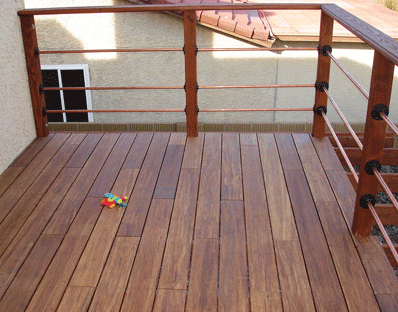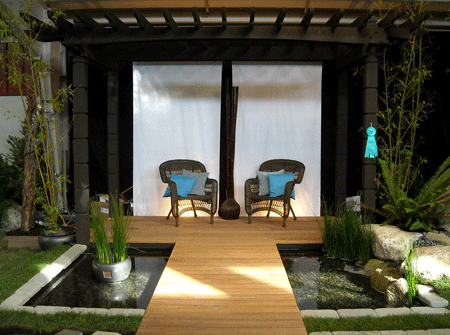Bamboo Decking For Decks, Siding And More Has Arrived
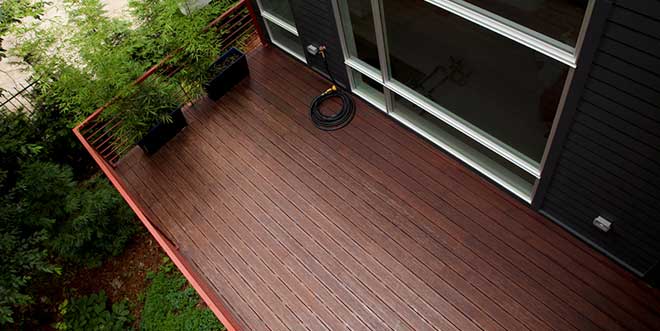
Have you been thinking about using bamboo decking for your next deck?
Worried About Durability?
Bamboo decking may not have been something you would have considered as a viable material for your deck. But exterior grade bamboo is now available - and with a 20 year limited warranty. More on that later. But first...
You have probably looked closely at other more common products like composites, or pressure treated, cedar and exotics. So what makes bamboo different? Let's take a closer look.
The first thoughts people have are often:
What is it?
How durable will it be?
How does it do in different climates?
All great questions and exactly what I set out to try to find some
answers on and get a better idea of the future of bamboo decking in the
residential deck world.
Things Have Changed Over The Last Five Years
As little as five years ago, there was not
really any proven bamboo decking material for outdoor applications.
Early products from other manufacturers that were around five years ago have long since disappeared because of the demanding outdoor conditions.
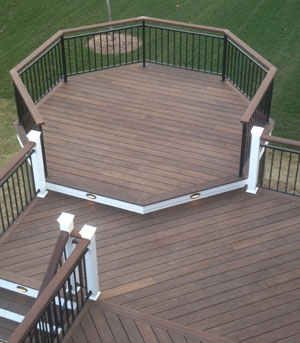
What was needed was a re-think on how to manufacture bamboo decking so as maximize all its great attributes - and minimize it's weaknesses.
Quick Facts
A Few Things You Probably Never Knew
- Denser than Ipe
- Consistently clear grain
- Sealed and stained easily
- High insect and decay resistance
- Class A fire rating ASTM E-84
- Highly stable when manufactured properly
- Harvested every 3-5 years vs 15-50 years for most other wood
- Absorbs 4 times as much carbon dioxide as hardwood.
Install It Like Indoor Flooring
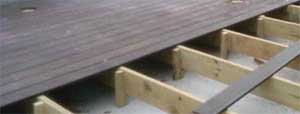
Strong enough to end match grooved boards between joists. This means less waste, less cutting, and faster installations similar to regular flooring.
let's take a closer look at two kinds of bamboo decking
Two Types Of Bamboo You May Have Heard Of For Decking And Outdoors
There are solid laminated lengths or strand woven pieces. They are very different and it's very important to know the differences before you buy.
Solid bamboo
This is the preferred material for outdoor decks. The boards are made from solid long lengths of bamboo.
They are then laminated together with glue under high pressure. These are proprietary and usually patented processes. They are more stable. They don't split or break apart.
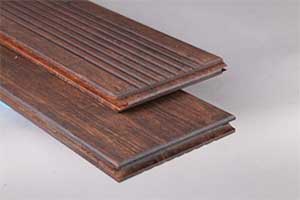
Strand Woven
This is the kind of bamboo you will most commonly see in the indoor flooring market.
It is made of smaller individual chips of bamboo and is not designed to be able to endure the demands of extreme heat, moisture or cold.
Photo courtesy of J&L Bamboo Products
So you should just try to avoid this kind of material for a deck application. There aren't any like this on the market in North America but if you ever did see some, stay away.
And now Composite Bamboo
Yes, composite bamboo decking is here and doing well. Read about the very latest product advances in this category.
Look For A Warranty When You Buy
So a well made solid bamboo material, engineered and manufactured for exterior applications along with time in the field - a proven performance record - and a meaningful twenty year warranty would be a good start.
Dasso XTR is one of the world leaders in exterior grade bamboo with this kind of history. Their fused bamboo has been on decks in North America and performing well.
Other important concerns
Environmental Effects Of Harvesting Bamboo
Bamboo is actually a member of the grass family and grows incredibly
fast - one to four inches a day! And it is ready for harvest within
five years.
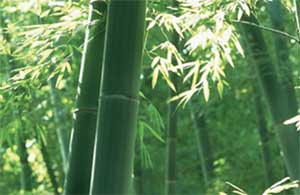
If you buy from a manufacturer that either owns its own land and farms its own bamboo, you can then be assured you are supporting an industry that is operating in a environmentally sustainable manner.
A manufacturer like Dasso XTR has its own bamboo farms allowing it to control and maintain the land. On the other hand, Southern Pine is harvestable at the earliest around fifteen to twenty years. Cedar or Spruce takes fifty to seventy years.
Maintenance
Bamboo decking and siding boards are a manufactured product which gives them amazing consistency but they are still a natural material.
As such, they will age and fade to a grey patina and perform similar to other exotic hardwoods.
This means to keep warranties valid the boards must be end sealed at the time of installation with something like Anchorseal and stained and finished with a penetrating oil like Penofin or Messmers.
So like other hardwoods, there will be some maintenance required but nothing compared to cedar or treated pine.
HOw Does Bamboo Compare to composite and hardwoods?
Shorter Six Foot Lengths
Bamboo that comes in consistent 6' lengths and with grooves on the ends of boards means its very easy to manoeuvre on the job site.
You can quickly lay down boards and just keep installing them end to end because the wood is so strong the ends can match between joists. You waste far less material. You spend less time planning board layout and cutting.
No Random Lengths For Less Wasted Material And Money
Hardwoods come in a variety of lengths. You have to sort them out. They are very heavy and cumbersome to work with. Composite boards are consistent lengths but very heavy also.
With hardwood and composite decking you will consistently lose ten to fifteen percent in waste. Your cost of material per foot goes up. Remember this.
Cost Comparison
Good quality exterior bamboo will be similar but usually a bit less than 5/4" grooved Ipe in cost which can range from about $4.40 to $4.90 a lineal foot. So bamboo in small quantity might cost about $4.50 or as low as $3.99 a foot in larger quantities.
Actual Cost Can Climb Depending On Wasted Material
There is a lot of planning that goes into designing the dimensions of a deck to maximize the efficiency of the materials used so as to match it up with the random hardwood lengths or the standard lengths of composites.
All perfectly do-able but more time and planning required in order to keep waste as low as possible.
But when you can lay down bamboo boards one after the other regardless of where joists are, your waste is minimized because the end of one board that is cut can be used on the end of the next run of boards keeping wasted material as low as possible.
What About Your Climate?
|
Check this out closely if you are considering outdoor bamboo decking for your next project. If you live in an area without a harsh winter or not too much rain you should have no worries.
If you do have a lot of moisture and snow and ice I would definitely apply a very good sealer on all six sides and follow the warranty recommendations. This is a good article to read. |
Photo courtesy of J&L Bamboo Products |
For example you have to wax end seal each piece and coat the top surface of bamboo and allow proper minimum ventilation underneath each deck board.
I know people have said it is performing well in places like Michigan and Ontario and I do hope time proves this to be true.
There's no denying is looks beautiful.
fused bamboo is now an option
This is brand new...
When I first wrote this article there was only one supplier of long strand bamboo I could find in North America. And they now seem to have disappeared. On top of that you will note my cautious but optimistic viewpoint on bamboo as a possible viable decking material.
Well I think I can now point you to someone who is bringing bamboo back to North America. And at first glance, appears to be a great idea.
It's called fused bamboo and is made up of almost 90% bamboo and the remaining 10% is phenolic bonding resin. At 3/4" thick and 5-3/8" wide and 6' long and with end matched tongue and grooves to join them beautifully and securely it looks like its worth investigating further.
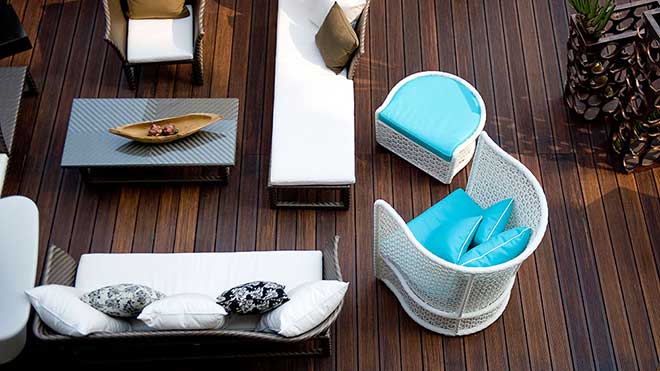
Some Final Thoughts About Bamboo
It's a very contemporary look yet still 100% natural and very environmentally friendly - but not totally proven.
Remember each board is manufactured of either long solid strands or tiny little woven pieces and held together by a mix of chemical glues and adhesives.
The entire integrity of the board depends on that glue never deteriorating, never failing and able to handle your weather year in year out. Without a know history yet I would say look at this as an experimental material for now.
And if you use it, seal it all six sides, and maybe
annually. Also maybe apply oils to keep it supple and healthy and go in
with your eyes open.
Consider this article your first introduction to bamboo decking and hopefully a great start. There is more to learn for sure. But so far bamboo seems to be living up to its stated performance.
Home > Deck Materials > Bamboo Decking





















